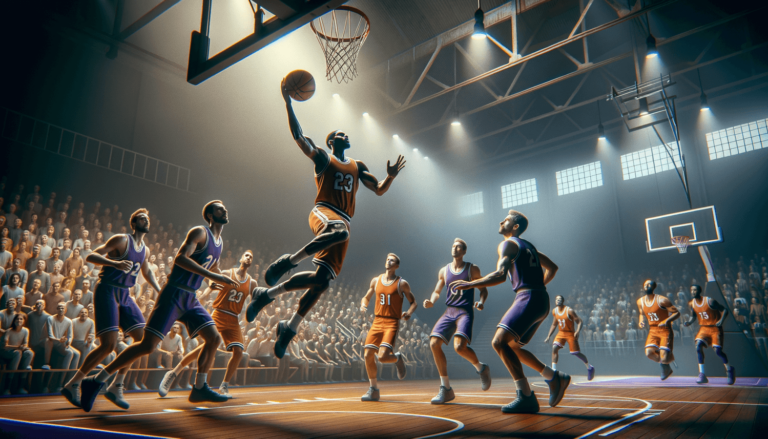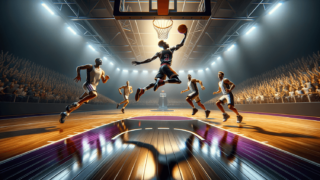
Have you ever heard the term “power layup” and wondered what it meant in the world of basketball? Well, you’re in for a treat! In this blog post, we’ll dive into the intricacies and techniques that make the power layup an essential move for both novice and seasoned players. So tighten your kicks, and get ready to explore this essential skill that can elevate your game to new heights while making a forceful statement on the court.
What’s a Power Layup in Basketball?
A power layup in basketball is an aggressive and forceful way of executing a layup that adds strength and control to the move. It typically involves a two-footed jump stop, using the body as a shield against the defender while protecting the ball, and maintaining balance before releasing the shot. This approach allows for increased stability and increased chances of scoring, even amidst tight defense or contact from opponents.
Mastering the Basics of a Power Layup
Before diving into the details, let’s get a grasp of the fundamental concepts that constitute a power layup in basketball. These principles can immensely help both beginners trying to learn new moves and experienced players aiming to polish their technique.
Principle #1: The Two-Footed Jump Stop
The two-footed jump stop is a critical aspect of the power layup. Approach the basket with a one-two rhythm, plant both feet firmly on the ground while maintaining a slightly wider than shoulder-width stance. This move allows you to shift your momentum and generate the necessary force to execute the layup. Mastering the two-foot jump stop is essential before attempting the power layup in a game situation.
Principle #2: Body positioning and Ball Protection
Keep your body between the defender and the ball to shield it from potential blocks or steals. Hold the ball securely by tucking it against your forearm while clasping it with both hands. This step ensures you maintain control over the ball throughout the whole movement.
Principle #3: Balance and Control
A proper power layup requires impeccable balance and body control to avoid traveling or losing possession mid-move. Work on your lower body strength and flexibility, so you can keep your center of gravity low and maintain balance. This skill will also help ensure your shot release is on point.
Step-by-Step Guide to Executing a Power Layup
Now that you have a good understanding of the critical principles, let’s break down the process of performing a power layup from start to finish. Follow this step-by-step guide to perfect your move and dominate the court.
Step 1: The Approach and Gather
Choose a comfortable angle to approach the basket, keeping your non-dominant foot forward (left foot for right-handed players and vice versa). Focus on maintaining a consistent rhythm and speed. When you’re a few feet away from the hoop, prepare to gather the ball by planting your non-dominant foot firmly on the ground.
Step 2: Jump Stop and Pivot
As you execute the two-footed jump stop, bend your knees, and maintain a low center of gravity for added stability. Pivot on your non-dominant foot, while bringing the ball to your hip on the shooting side. Your shooting arm should be at a 90-degree angle with the elbow pointing toward the ground.
Step 3: Shielding and Ball Protection
While pivoting, use your body to shield the ball from the defender. This step involves moving your non-shooting arm and shoulder between the opponent and the ball. By doing so, you create a physical barrier, making it difficult for them to strip the ball or block your shot.
Step 4: Jump and Shoot
After successfully pivoting and positioning your body, it’s time to execute the jump and shoot. Jump off both feet, raising the ball towards the basket, using your shooting hand to guide the shot. Keep your eyes locked on the target, and release the ball at the peak of your jump. Aim for a soft touch off the backboard, allowing the ball to bounce into the hoop.
The Importance of Practice and Repetition
As the old adage goes, “practice makes perfect.” To become proficient at power layups, it’s essential to put in the time and effort to develop muscle memory and enhance your skill set. Here are a few tips to help you plan your practice sessions effectively.
Tip #1: Break Down the Movements
When first learning the power layup, practice each movement separately to ensure proper technique. Focus on mastering the two-footed jump stop or perfecting ball protection before attempting to combine all the elements into a seamless move.
Tip #2: Use Drills to Improve Specific Aspects
Once you’ve worked on individual elements, incorporate drills into your practice sessions that specifically target different aspects of a power layup. These drills can help build your strength, speed, and agility while reinforcing the proper mechanics of the move. Some useful exercises include ladder drills for footwork, box jumps for explosive power, and wall sits to strengthen your lower body.
Tip #3: Consistency is Key
Incorporate power layup practice into your regular basketball training. Doing so will ensure that you’re consistently working on your technique, making it an automatic part of your basketball repertoire. Dedicate time each week to refining your skills, and you’ll see steady improvement over time.
Addressing Common Mistakes in Power Layups
When working on the power layup, it’s crucial to stay aware of potential mistakes that can prevent you from executing the maneuver effectively. Let’s look at some common pitfalls and how to address them.
Mistake #1: Poor Footwork and Timing
Ensure a proper one-two rhythm as you approach the basket, planting both feet on the ground simultaneously. Improper footwork or incorrect timing can lead to traveling violations or weak shot attempts. Focus on perfecting your approach by paying attention to your rhythm and foot placement during practice sessions.
Mistake #2: Overlooking the Non-shooting Arm
Neglecting the role of your non-shooting arm can lessen the effectiveness of your power layup—use it for shielding the ball or maintaining balance. During practice, concentrate on synchronizing your non-shooting arm’s movements with the rest of your body for optimal control and stability.
Mistake #3: Hurrying through the Movement
When learning the power layup, take your time to perfect each step of the process. Rushing to perform the entire move can result in poor technique and lack of control. Focus on understanding the mechanics and executing each step smoothly before increasing your speed.
Adapting the Power Layup for Advanced Situations
Once you’ve mastered the basic power layup, it’s time to challenge yourself with more advanced scenarios. By making specific adaptations to the technique, you can continue to elevate your game and keep defenders guessing.
Variation #1: Reverse Power Layup
The reverse power layup involves executing the move from the opposite side of the basket. Approach the hoop from one side, but instead of shooting on the near side, jump across the rim and release the ball on the opposite side. This move is particularly useful when dealing with larger defenders, as it provides additional protection from potential shot blockers.
Variation #2: Power Layup with a Fake
Incorporate fakes or shot variations into your power layup to make it even more unpredictable. Perform a pump fake or a shot fake to throw defenders off balance, providing an opening for you to execute the power layup. Mastering this technique will require agility and quick decision-making during game situations.
Variation #3: One-handed Power Layup
Once you’ve developed a strong base in executing a power layup, you can challenge yourself further by attempting a one-handed power layup. This variation is slightly more difficult, as it requires greater strength and control in the shooting hand. It can be an effective way to surprise your defender with a quick release.
Now that you’re equipped with the knowledge and technique required to execute power layups in basketball, it’s time to hit the court and put everything you’ve learned into practice. With determination and consistent practice, you’ll soon find yourself an unstoppable force on the court!
Developing Strength and Conditioning for Power Layups
Like any basketball skill, the success of your power layup heavily relies on your overall physical condition. Building strength, conditioning, and flexibility will allow you to power through defenders and finish strong at the basket. Let’s examine some exercises that target relevant muscle groups and enhance your power layup capabilities.
Exercise #1: Squat Jumps
Squat jumps help develop both lower body strength and explosive power, which are crucial for executing a forceful power layup. Incorporate these into your regular workout routine to improve your vertical jump and speed off the ground.
Exercise #2: Plyometric Push-ups
Plyometric push-ups strengthen your upper body and core, providing the stability and control necessary for a successful power layup. By incorporating these into your training, you’ll notice improved finesse and strength in your arm movements during the layup.
Exercise #3: Single-Leg Deadlifts
A strong core and glutes are essential for maintaining balance during powerful moves like the power layup. Single-leg deadlifts target your core, glutes, and lower back, allowing you to improve stability and body control when performing the power layup.
Exercise #4: Lateral Movements and Agility Drills
Working on lateral movements and agility drills can significantly enhance your ability to approach the basket at various angles and adapt to different defensive situations. Incorporate exercises like cone drills and lateral skater jumps into your training regimen to build speed, dexterity, and lateral stability.
Adding Mental Toughness to Your Game
While physical ability and technique play a massive role in basketball success, mental toughness can often be the determining factor between an average and outstanding player. A strong mindset is essential when executing the power layup, as it requires confidence and determination to push through defenders and finish your shot. Below are some tips to help build your mental strength on the court.
Tip #1: Embrace Pressure Situations
Pressure situations can stimulate growth as a basketball player, allowing you to develop the mental fortitude necessary to deal with challenging game scenarios. Regularly expose yourself to high-intensity game situations, scrimmage with advanced players, and simulate critical end-of-game moments during practice to enhance your mental resilience.
Tip #2: Develop Positive Self-talk
The power of positive self-talk should not be underestimated. Encourage and motivate yourself with affirmative thoughts during practice and games, reinforcing belief in your ability to perform the power layup. By doing so, you’ll be better equipped to overcome setbacks and execute under pressure.
Tip #3: Visualize Success
Mental imagery can have a significant impact on your ability to perform successfully on the court. Regularly visualize yourself successfully executing the power layup in various game scenarios, allowing your mind to build confidence and familiarity with the move. This mental practice will help you stay composed and confident while attempting the layup during actual games.
Tip #4: Learn from Mistakes
Mistakes can be valuable learning opportunities if you approach them with the right mindset. Reflect on your power layup errors and dissect the root cause of the issue, allowing you to make necessary adjustments and improvements. This growth mindset can accelerate your improvement and keep you driven to master the power layup.
By devising a comprehensive plan that includes proper technique, strength and conditioning, and mental toughness, you will be well on your way to dominating the court with your power layup. Take the time to hone this skill, and you’ll experience the rewards both on and off the basketball court.
FAQs: Power Layup in Basketball
Here are some frequently asked questions and answers to help quench your curiosity and address potential concerns regarding the power layup in basketball. Remember, practice and persistence are key to the mastery of any skill.
1. How is a power layup different from a regular layup?
A power layup involves a two-footed jump stop, which provides increased stability and control while taking the shot, as opposed to a regular layup where you jump off one foot. The power layup also emphasizes shielding the ball with your body, enabling you to execute the move amidst tight defense or contact from opponents.
2. How can I improve my power layup shot accuracy?
Improving shot accuracy is a matter of consistent practice and understanding proper mechanics. Ensure you follow each step of the power layup carefully and focus on a smooth motion throughout. Additionally, pay close attention to your shot release and develop a consistent trajectory aimed at the target on the backboard.
3. Is a power layup applicable in real-game situations?
Absolutely! A power layup can be a game-changer, especially when facing strong defenders, as the added force and body protection can improve your chances of scoring. Practicing the move also helps build muscle memory, making it more instinctive and accessible during high-pressure game situations.
4. How can I improve my footwork for power layups?
Improving footwork for power layups requires focused practice on your rhythm, foot placement, and balance. Consider incorporating agility and footwork-specific drills like ladder exercises, cone drills, and high-knee skips into your training regimen. These will help to enhance your dexterity and coordination, translating to fluid footwork during actual gameplay.
5. How do I execute my power layup against taller defenders?
Employing body shielding techniques and trying reverse power layups can increase your chances of success against taller defenders. By using your body to protect the ball and shooting from the opposite side of the basket, you can evade potential shot blockers and make it difficult for taller defenders to strip the ball from you.
6. What additional tips can I use to become more efficient at power layups?
Achieving proficiency in power layups requires consistent practice, strength training, and flexibility exercises. Additionally, building your mental toughness, working on shot fakes, and maintaining a growth mindset can propel you towards efficiency with this powerful move.
7. Can left-handed players execute power layups effectively?
Yes, left-handed players can execute power layups effectively by mirroring the steps in the technique. Mastering the power layup as a left-handed player can help you develop into a versatile and dynamic basketball player, as it enables you to score in various situations against different defenders.
8. How can I make my power layup more deceptive?
Incorporate fakes or shot variations into your power layup for added deception. The use of pump fakes, shot fakes, and reverse layups can keep defenders guessing, providing opportunities for you to capitalize on unexpected openings.
9. Can a power layup be executed while dribbling with my weak hand?
Yes, a power layup can be executed while dribbling with your weak hand. It’s essential to develop ambidextrous ball-handling skills to become a more versatile and unpredictable player on the court. Practicing dribbling and layup drills with both hands will help you achieve this level of proficiency.
10. How can I work on my endurance for executing power layups during a game?
Building endurance for executing power layups throughout a game requires a combination of cardiovascular conditioning, strength training, and on-court practice. Implement exercises like running, cycling, high-intensity interval training (HIIT), and circuit training into your workout routine to develop excellent game-time endurance capabilities.
Featured Posts
- No pillar pages found.





